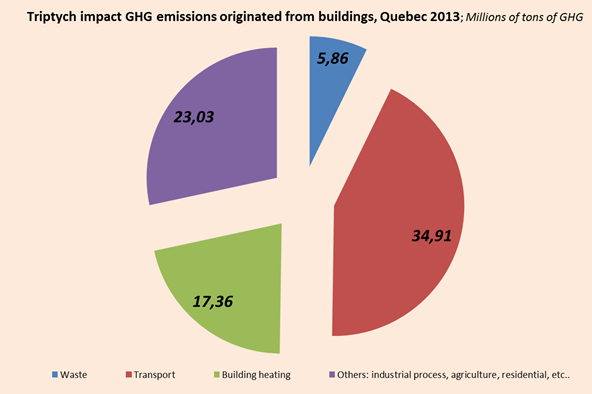Every conscious act carries its own value, this is why everyone should be encouraged to participate in change. Technological innovation materializes by its adoption, its accessibility and by its conscious use, this is what we call behavioral change.
The majority of non-residential buildings in the Quebec economy, which are a direct source of GHG emissions , are a home to industries, commercial businesses and public institutions. There are more than 236,800 small and medium entreprises (SMEs) and 1,112 municipalities in Quebec which are not subject to the regulated carbon market in Quebec, the RSPEDE . They exercise their economic activities in the perimeter of tens of thousands of buildings. The occupants of these buildings in Quebec are powerful drivers of change. Their desire and willingness to do differently and more efficiently are the main requirements for a green economy, low in carbon emissions. The offer, or a basket of measures, consist primarily of new behavioral practices, integration of a variety of green technologies “ Clean Techs “ and carbon regulations, green and scalable.
According to the latest available inventory, GHG emissions in Quebec in 2013 were 81.16 million tons . This inventory segments these emissions into 6 categories according to the IPCC methodology. We find that over 71% of all of Quebec’s GHG emissions come from transport, management of waste and fossil energy used for heating non-residential buildings (excluding emissions from industrial processes ). This triple combination of GHG emissions come from more than 99 % of SMEs, municipalities and buildings of public and parapublic sectors in Quebec. Each of these buildings, emitting ≤ 25 000 tonnes of GHG’s, are not subject to the regulated carbon market (the RSPEDE). Note that in 2012; nearly 76 % of Québec’s GHG emissions come from entities not subject to RSPEDE.

The life analysis of a building over a 20 year period indicates that about 50% of total costs consist of operating expenses such as energy, waste management and others. Acquisition costs of a building are ≈ 11 % of total costs. Other costs consist mainly of taxes (on fuel, carbon tax, tax on materials) and property taxes or tariffs (such as for water). If we include the transportation dimension, considering all buildings as the point of departure and arrival of goods and people, we thus obtain three budgetary items that can serve as the base for “green” change.
The Sustainable Community solution, developed and operated by Will, focuses on a triptych approach that can stimulate change, with the building as a pivotal point on energy aspects, waste and transportation. This solution provides a simple and direct economic stimulus that promotes maximum return of voluntary monetization for each occupant of the building participating in Sustainable Community based on each of its eligible, completed and verified reduction efforts. The impact of each voluntary gesture of carbon reduction reinforces the environment and social commitment. Active participation in Sustainable Community confirms the social recognition of the contribution of thousands of stakeholders in climate challenges.

At the worldwide level, various mechanisms to put a price on carbon through a basket of measures, constitutes a universal and buoyant economic signal. The voluntary contribution reinforces this signal while integrating all the stakeholders of civil society in innovative action, socially recognized and valued.
To comment our blog: [email protected]
Martin Clermont, CEO, Will Solutions.

